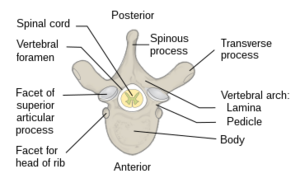Laminotomy
Original Editor - User Name
Top Contributors - Nomvula Dlamini and Kim Jackson
What Is A Laminotomy?[edit | edit source]
A laminotomy is a surgical procedure where a part of the lamina, also known as the vertebral arch, is removed from the vertebra. A laminotomy would typically be performed to relieve pressure on the spinal cord or nerve roots. This pressure can cause pain, numbness, weakness, and other symptoms. A laminotomy is less invasive than a laminectomy. Unlike with a laminectomy where the lamina is completely removed, a laminotomy does not remove as much of the ligaments and muscles attached to the spinous process. It requires less of the bone to be removed from the vertebra.
Causes of Spinal or Nerve Root pressure[edit | edit source]
Benefits of a more minimally invasive procedure[edit | edit source]
Laminotomy better preserves vertebral stability.
Resources[edit | edit source]
- bulleted list
- x
or
- numbered list
- x
References[edit | edit source]
- ↑ Procedure Endoscopic Laminectomy. Available from: https://www.youtube.com/watch?v=U8wZ7uX75fw [last accessed 24/11/2023]







